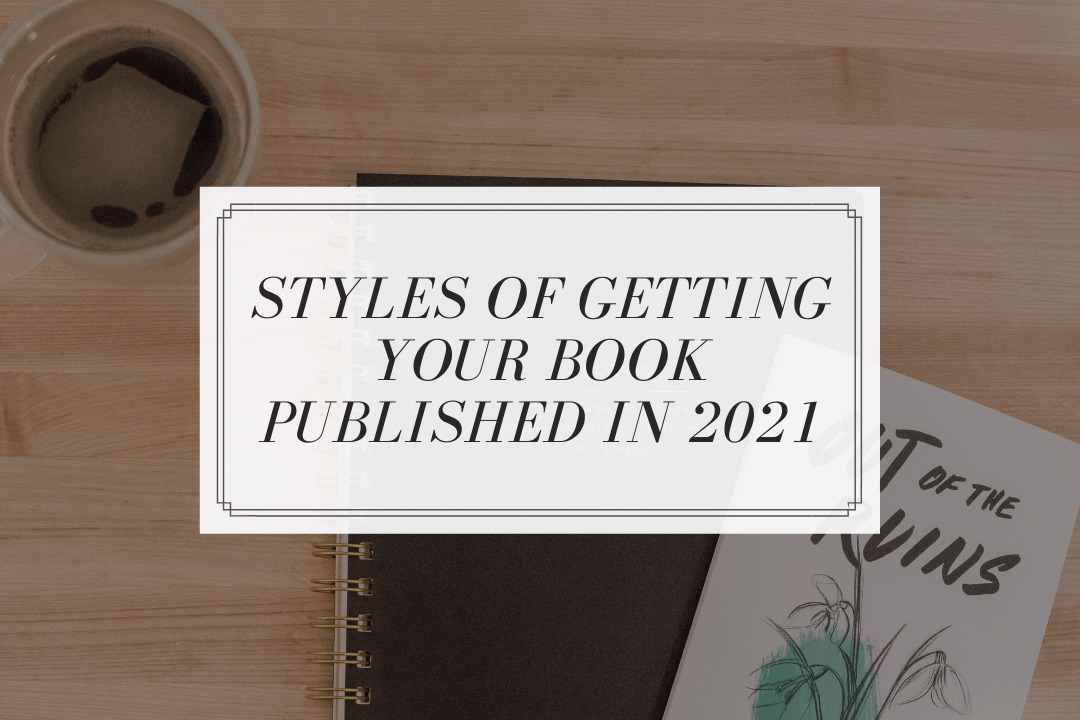Styles of Getting Your Book Published In 2021
The Quick and Short of Fast Paced Book Publishing
The Impact is at the Cornerstone of Culture
The book publishing, and general publishing industry is at the very cornerstone of our culture. The dissemination of all types of information, happens through the writing, publishing, distribution and sale of books/ebooks. The impact that the publishing industry has on our society is incalculable. It is an industry that will survive every possible lull and recession, however its rate of evolution and digital adoption may vary. Innovation in the space isn’t really something that gets put on high priority
The invention of publishing which was believed to have occurred in China around 1,400 years ago allowed us to record information on paper in a lasting manner, however, the process was still held to a snail’s pace at the time. It wasn’t until the 19th century that publishing took on a form that is most similar to what we have today or think of as our publishing industry. Fast paced printing capabilities, a standardized process and a blend of commercial viability and intellectual idealism that makes the publishing industry hold a vital responsibility in society for simultaneously staying profitable and spreading valuable intellectual thought.
This is why, the modern writer, must have a good grasp not only of what the publishing industry is looking for but also how the business works. Having something interesting, and worthwhile to say, is key. If you are going to write a book, in a plethora of other books already on the market, you must have something interesting to add to any conversation that is currently ongoing or, start a new conversation altogether. Besides that, it goes a long way to study the publishing industry and to be aware of what is currently selling. It doesn’t necessarily mean that trends that are pre-existing are waves that you should ride, because there’s a possibility that by the time your book is on the market, that trend swelled and died, and your book would be out of place, but also because chasing after a trend can weaken your material.
However, keeping track of trends, to be able to forecast upcoming trends is a valuable exercise. Knowing that your book might be hot when it comes out, helps make your pitch to larger publishing houses easier.
Who Are The Big 5+1 of The Publishing World Today
The major publishers in the industry today are the same companies that have been around for a while. Many of the following names are ones that you would see on the covers of books on any person’s book shelf; Penguin/Random House, Hachette Book Group, Harper Collins, Simon and Schuster, Macmillan. Either of those book publishers are likely to be near you in some sense. The other company that is a feasible addition to this list, would be Amazon. The best way to get noticed by any of these 6 companies, would be to ideally tie up with a competent agent. It is possible to get noticed and land a deal without an agent, but it is not easy. The agent’s entire job is to dedicatedly maintain channels to the major publishing houses and act as an intermediary between the writer and the publisher. So by getting an agent on your side, and proving to them (because you would have already done your research on the market viability of your book) makes entry into the world of publishing a trazilion times easier!
How To Land An Agent
Make the agent’s life simple. Write A great book, make sure your manuscript is relevant and entertaining, but also, make it easy for the agent to notice just how great it is. A simple way to do this, is to deliver a query letter followed by a one page synopsis with the book that makes it sound very attractive, pair this with some cool looking cover art and that could go a long way in making sure that an agent that gets 1000s of submissions, actually takes a look at your manuscript. Another surefire thing that gets you dismissed from being selected for publication is poor or unprofessional grammar, and editing. Making sure your entire book is perfectly edited, and that your first few chapters are particularly captivating, ensures that the agent reading it, doesn’t get taken out of the experience, and throws your book in their already very large “that ain’t getting published” pile.
No Thank You, Agent Smith
If you don’t want to work with an agent and want a way around, there is always the ever growing self publication industry. The self publishing industry has its pros and cons just like everything else, one major pro is that you don’t have to appease a lot of other people, a major con is that your book may not get the same reach unless you know how to play the game. The name of the game in self publishing is pre-sales. Making sure you have enough pre-sales is everything. Working the channels like WSJ, Amazon and The New York Times so you can get on the bestseller’s list is your best shot and making sure your book actually sells. Once you have a self publishing success, it also makes that second book, in case you are the sort of masochistic loner that wants to publish a second, or maybe even a series of books, the following ones are always easier after you’ve had one success.
Let’s Say You Have Bestseller On Your Hands
A best seller is not something that is to be taken lightly. A real bestseller can make waves throughout the industry. It can impact readers, other writers, and culture. But, if you are the writer itself, and you haven’t yet published your bestseller to be; one major question that you are probably contemplating is: what type of publishing method is best for my book right now?
Surely, you’ve weighed the options, especially I’m sure that self publishing vs landing a publishing deal has been a major consideration, however, the publishing industry has surely evolved to include a range of different hybrid deals. When approaching a publisher today, you might want to keep in mind that they will suggest a possible hybrid deal; where you share costs to get the book off the ground, but also you share control. It comes with financial costs, but also the major benefit of having input on many major decisions down the road.
Hybrid deals are becoming more and more popular. With writers wanting to either retain some control while getting the reach of the already established publisher, and publishers wanting to reduce risk, this allows for some pretty cool collaboration between writer and publisher. It’s, of course, vital who you end up collaborating with, a negative relationship in a hybrid deal can ruin the wonderfulness of having your book out in the world for others to buy. While I think the hybrid publishing thing has a lot of merit, picking the right publishing partner in the deal is key for it to go well.
One factor that often gets overlooked in publishing, that could greatly influence whether you decide to choose to be self-published, use a publisher or pursue a hybrid arrangement is the amount of time it takes to finish all of the steps to get your book to market for each one. Typically, a concentrated effort within a self publishing model doesn’t take as long, or in other words, is faster than all other methods. The reason usually being, because the only person you have to check with: is you. All decisions are your own, and all of the back and forth that comes with collaboration gets eliminated. Conversely, adopting a hybrid approach can be draining in many circumstances because it could take a long time when control is shared, once again, this is why the relationship in a hybrid publishing deal can be extremely important, you want to pick someone who is not only easy to work with but who you can find commonalities in the decision making process with.
Service Publisher As A Means of Getting Yourself Out There
Service publishers are publishing services for hire. They are a possible route for someone who has a manuscript they are very keen on getting published but do not want to or cannot really justify landing a major publisher. This provides the opportunity for people who have a manuscript they are determined to get published and have the financial resources to pay for a large extent of the services; such as design, marketing and publishing services, to put up some money and get their book on the market. When getting your book published, there is a certain mandatory level of analysis that is done on the sales projection or market viability of your book, if the book doesn’t meet those requirements it may turn away some major publishers but in no means defines the book as a bad book. On the contrary, many times books are written of high quality that may just not be commercially viable but certainly worth publishing. This is where the hybrid style of service publisher could be an option. Sometimes, this can be the best thing for getting out a book that has something really important to say but isn’t an obvious commercial bestseller.
There are some danger points to look out for when utilising service publishers. In some cases service publishers retain the intellectual property rights of your book. That’s something that would make further steps down the road, either getting your book republished or wanting to change elements later on impossible. The lack of ownership and the extent of marketing that they will actually do on your behalf are two clauses that are often points of contention in service publishing contracts.
Traditional Book Publishing Companies
A swanky traditional book publisher will have all the hot connections in the book publishing universe but both the mid-size and large scale publishing houses will be looking to turn a profit. Not that other companies aren’t looking to get bang for their buck, but the traditional large publishing houses will be less willing to go outside of their formulaic model to achieve their desired bottom line. If you have a manuscript that’s a bit avant-garde, a tad experimental, maybe a little bit of a head-turner, then you might want to start with a small scale traditional book publisher first. Of course like a door salesman somewhere once said, “Knock on a hundred doors, and eventually, someone will grant you a book deal.” Or, perhaps I am paraphrasing. In any case, if the big 6 publishing companies or even mid-size ones don’t at first jump at giving you a deal, make sure you explore the smaller publications, before changing direction if the traditional route is your preferred method. The odds may be that you just have something a bit more unique that a smaller publishing company would only be too happy to take on their slate.
The downside to traditional publishing at least in contrast to self or hybrid publishing (which is also known as “author-assisted publishing,” “independent publishing,” “partnership publishing,” “co publishing,” and “entrepreneurial publishing”) is that because you are essentially the same as a wandering startup company looking for investors is that once you sign a contract with a publishing company you give up some amount of control. A fair bit of control depending on the relationship. This is something you have to be prepared for, book publishing companies are built to sell books, and sometimes they will make certain decisions that are going to alter your original vision but are likely to make you more money in the long run.
Timing Your Launch
Timing a book release is incredibly integral to those coveted sales numbers coming back like the grand prize at the county fair: nice and plump. There’s a reason why all content; tv, movies, books, songs, and beyond are released around certain seasons, all of it has to do with timing. Timing your book’s release, if you decide to self publish or hybrid publish for that matter, I really do recommend keeping an eye on what books of similar style, genre and audience are picking up, and timing the sale of your own book to capitalize on those trends. By ensuring that the book has the backing of a well timed release, and a good release strategy, then you can rest peacefully knowing you are doing all that you can and leave the rest to the book gods.
What Are The Cool Kids of Publishing Upto?
The book publishing industry has grown 53% in the past 10 years in the United States. Down from when the industry was turned on its head, there seems to be a sort of resurgence of independent bookstores. It’s unexpected but a welcome sight for the sore eyes of avid readers and writers across the country.
Interestingly, all three sectors of audiobooks, print books and digital editions are all up in sales in recent years, with more individual copies being sold off shelves than before, it seems consumers are back to wanting to hold a book in their hands while still continuing to grow their digital consumption as well. Currently the rate at which audiobooks are growing is greater than the rate of growth of the ebook category and we could potentially be seeing audiobooks overtaking all other forms of book consumption in the next 4 years.
As more and more publishing companies near me and near you pop up, along with more and more book stores this means a wider range of places for your book to the shelves. The rise of the industry and the projected growth only continues to be a positive for any players looking to enter the industry. Smaller publishing companies that are more mission driven, and aim to disseminate certain brands of knowledge or information are also popping up across the lands and creating opportunities for aspiring writers. Smaller publishing companies are less likely to be stringent about shopping your book around and allow writers to submit their manuscripts to multiple houses at once – increasing your odds of being published, while decreasing how long it takes for you to be discovered. These efforts paired with that of more independent bookstores hanging on, make the global market more attractive than it was in previous years for unknown writers to enter and get their book published. The global market is currently an over 100 Billion dollar industry already and is expected to grow significantly over the next 10 years. The U.S and China account for large amounts of that overall global market and are also two fast growing markets, with China growing faster than anyone else.
Interestingly, not all forms of writing are growing at the same pace within the industry. Short stories and fictional novels are actually seeing a bit of a decline in recent times, one possible theory being that the explosion of on demand video content and social media that people are occupying their leisurely time with more visual content instead of reading fiction for pleasure. But, with that comes the marvelous and once again unprecedented (isn’t that the word of 2020) rise in previous years of poetry. A commonly perceived dying art form and for many decades now people have been moving away from purchasing poetry in any form, the industry has somehow seen a rise in poetry in the past 5 years. With the rise in this trend, we can infer that people are once again perhaps looking for content that is high impact but in a short amount of time.
Another area that doesn’t seem to be hitting the brakes anytime soon and is seeing consistent growth amongst adults who read in the U.S is the religious book category. Religious texts have not slowed in sales at all, and continue to be a leading category for book sales to adult readers. Something tells me that isn’t slowing down anytime soon either. As for the self publishing sector, we have roughly between 1.5m to 1.8m books being self published each year with the Amazon CreateSpace being the most predominantly used service to create and launch these books. There’s a reason why Amazon is a leader in the book publishing and book selling space, the company was conceived as an online book seller and with their now decades worth of experience in the market, they know a thing or two about what they are doing for both book sellers and book buyers.
While the average spending of an American adult on book publishing per year is dismally under $100 per year, that statistic is in diametric opposition to the increased sales being seen in self-publishing every year. With the U.S accounting for over 25 billion in the global publishing market, and growing year on year, we are seeing the publishing industry evolve and adapt to the new customers and technology that are entering the space. With all the amazing options and types of deals and information at your fingertips, this only further corroborates the idea, that if you are someone with something to say and have the fortitude to put it down and wrap it up – you have maybe the best odds of getting those ideas in a book – on a shelf – for someone to read – than maybe, ever before.




